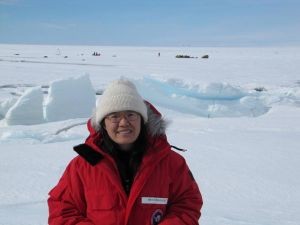19 January 2016
Researchers discover surprising waves in the Antarctic atmosphere
Posted by Nanci Bompey
By Katy Human
Researchers who have spent thousands of hours observing the atmosphere high above Antarctica have discovered a previously unknown class of wave that ripples constantly through the atmosphere, likely affecting high-level winds, climate, and even Earth-based communications systems.
Every three to 10 hours, these “persistent waves” sweep through the mesosphere, a region of the atmosphere that begins about 50 kilometers (about 30 miles) high, the researchers report in the Journal of Geophysical Research—Space Physics, a publication of the American Geophysical Union.
“These waves are very large perturbations, causing up to 100-degree Fahrenheit changes in temperature in less than five hours, and every time we look, we see them,” said lead author Cao Chen, a Ph.D. student in the University of Colorado Boulder’s Cooperative Institute for Research in Environmental Sciences (CIRES) and Aerospace Engineering Sciences department.
Chen and his colleagues, including corresponding author Xinzhao Chu, a CIRES Fellow and professor of Aerospace Engineering, have spent much of the last five years operating a sophisticated, custom-built lidar system in Antarctica. Their goal has been to study some of the most remote, difficult-to-observe regions of Earth’s atmosphere—where it meets space, up to 200 kilometers (125 miles) high.
The work relied on years of strong support from the National Science Foundation’s U.S. Antarctic Program and from Antarctica New Zealand, which, among other things, hosts the lidar in a new facility at Arrival Heights, about 3 miles north of McMurdo Station.
Every year, at least one of Chu’s graduate students has overwintered at Antarctica to ensure continual, careful lidar observations, and the new discovery reflects that team’s dedication, Chu said.
“This is a triumph for lidar observations,” she said. “This is a surprise, a truly novel discovery, and we could not have made it without such long data sets.”

Xinzhao Chu, Jian Zhao and Cao Chen celebrate outside the Antarctica New Zealand building at Arrival Heights, Antarctica,
following a season of extensive lidar observations of the high atmosphere.
Credit: CIRES and CU-Boulder.
The data reveal a continual rippling of temperatures in two layers of the atmosphere called the mesosphere and the lower thermosphere, from as low as -122 degrees Celsius to as high as 32 degrees Celsius ( -189 degrees Fahrenheit to 90 degrees Fahrenheit). At 97 kilometers (60 miles) high, the temperature swings reach 38 degrees Celsius (100 degrees Fahrenheit). Chu’s team made observations for 5,500 hours during the last five years, up to 174 hours continually, and never saw the waves calm.
The mesosphere and lower thermosphere are much higher than the troposphere (the atmospheric layer where most clouds form and winds blow) and the stratosphere (the layer where high-levels winds blow and ozone holes can form). Even so, what goes on in the mesosphere and lower thermosphere doesn’t stay there. These waves can carry energy from one region of the atmosphere to another, likely influencing not only weather and climate patterns, but the upper atmosphere, where radio waves bounce and satellites operate.
“If we can determine where these waves originate,” Chu said, “it might help us dramatically improve climate and space weather models that try to predict how the atmosphere behaves.”
For example, climate models consistently make the far southern stratosphere too cold, a problem for forecasting ozone depletion. “This discovery may shed light on a persistent issue in climate models, the so-called cold pole problem,” said Adrian McDonald, a professor at the University of Canterbury in New Zealand. McDonald has worked closely with the Chu research group, but was not directly involved in this analysis. “Because of the temperature-sensitive nature of ozone chemistry, this has wide ranging impacts on predictions of the severity of ozone depletion,” McDonald said. “These results could therefore be very useful for climate models focused on the polar region.”
— Katy Human is Communications Director of the Cooperative Institute for Research in Environmental Sciences (CIRES) at the University of Colorado Boulder. This post originally appeared on the CIRES website.











 GeoSpace is a blog on Earth and space science, managed by AGU’s Public Information staff. The blog features posts by AGU writers and guest contributors on all sorts of relevant science topics, but with a focus on new research and geo and space sciences-related stories that are currently in the news.
GeoSpace is a blog on Earth and space science, managed by AGU’s Public Information staff. The blog features posts by AGU writers and guest contributors on all sorts of relevant science topics, but with a focus on new research and geo and space sciences-related stories that are currently in the news.